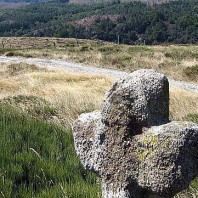Hiking the Regordane Way
H
Hiking the Regordane Way is a 100-kilometre section of the historical route that links Paris to Lower Languedoc. It forms approximately half the length of the longer Saint-Gilles Way that runs from Le Puy-en-Velay to Saint-Gilles-du-Gard, a 140-mile walk that was Christendom’s fourth major pilgrimage around the early Middle Ages.
Whilst records first mention the Regordane around the middle of the ninth century, it was the above-mentioned pilgrimage that launched it as an important thoroughfare, en route to the tomb of Aegidius in St-Gilles abbey and beyond: as a point of departure for St Jacques de Compostella, the Holy Land (St Gilles was a Mediterranean Port at the time) and Rome.
The Regordane welcomed some illustrious travellers along its course: King St Louis, in 1254, who departed from Aigues-Mortes en route to the Crusades; Simon de Montfort, in order to crush the Cathars after the killing of the Pope’s emissary at St Gilles; and Louis XIV’s armies, sent to crush the Camisards in The Cevennes some 500 years later. Many a destroyed castle and church along the way bear witness to the devastation caused by these last two episodes in French history.
There were many reasons for the gradual demise of the Regordane, perhaps the key one being the eastward expansion of Gaul from 1308, which saw the Rhone Valley supplanting the Regordane Way as France’s main eastern frontier route.
Nevertheless, there was a renaissance period during the early industrialisation of the ‘Alèsian Basin,’ as capitalists sought an alternative and faster route to Paris and northern markets for Languedoc’s coal, iron and steel, wine, salt and silk.
Eventually, the natural geological fault-line through which the Regordane passes experienced major investments in both road and rail, and once again the original path fell into disrepair or was forgotten.
Hiking the Regordane Way commences in Pradelles, a charming, medieval granite town on the volcanic plateau of the southern Massif Central. One of only four remaining pilgrimage “Maladreries” marks the point of departure. They were refuges that comprised a chapel on one side of the road, accommodation on the other, and a raised walkway that straddled the road and linked the two together – which afforded much-needed shelter during the seasonal rains.
You head south from the town and soon discover the first granite rocks of the sacred path just south of La Ribeyre. A section of this medieval trail, that had been lost until recently, has been miraculously resuscitated after Pestel. Further on, past Lesperon, you walk the ‘Royal Route’, the name given to the 18th century paved surface. You then wade carefully across two streams, and pass through several charming hamlets, before arriving in La Bastide and your first overnight stay.
Your second day’s Hiking the Regordane Way experience is a master class in hill-walking, as you discover ‘montjoie’ (stone waymarks), dolmen and mule drivers’ cartwheel tracks engraved deeply into the granite rock pavement, testament to the trading importance of this route in bygone times – deep incisions are visible from both the twelfth and thirteen centuries, as well as the eighteenth, distinguishable by the differing wheel gauges of each epoch.
Thereafter the path follows the hill-crest before descending spectacularly into the Chassezac gorge. It resurfaces on the southern bank (several bridges were washed away by torrents) and heads due south across volcanic plateau into the spectacular scenery of the Gorge and the medieval village of Garde-Guerin, perched beside its steep slopes.
You are likely to catch site of ‘local hikers’ here, before you continue southwards on the remarkable ‘Bayard coast’ path to Villefort, past lake, magnificent stone railway viaduct and over dam – all under the watchful eye of Mont Lozère, the region’s most imposing mountain.
Your third and final day of Hiking the Regordane Way along the Reformation trail sees you following the important fault-line down through low-lying Villefort, pass the source of the River Cèze and experience a change of vegetation with the presence of the Cevennes’ first green oak trees.
You alternate between ancient trail and tarmac route, as you descend the valley through linear settlements towards the Huguenot stronghold of Genolhac and its mercantilist ‘Grande Rue.’
Walking south from Pradelles along this ancient path fills you with innumerable conflicting emotions. You commence your journey on ancient tracks and the paved ‘Royal Route’ across the splendid isolation of a granite volcanic plateau where, apart from under-populated villages, the only signs of human life are those of the occasional farmhand. You stumble upon your first sizeable settlement only at the end of your second day’s hiking.
The dissected valley into which you plunge on Day Three is replete with the history and vestiges of France; from Roman times, through to the upheavals of the Camisard Uprising (The Cevennes own bitter chapter of the Wars of Religion) and onwards until the height of the Industrial Revolution.
The linear settlements have seen no growth since. On the contrary, most have stagnated due to industrial decline and rural exodus and remain ossified in the architecture of a bygone era. It is not until you arrive at the edge of Alès that you discover what the whole ‘Idea of Progress’ was supposed to be about.
In this practical-French-history-lesson-par-excellence, you learn what it must have been like to travel on the crude surfaces of the Middle Ages, be it alone as a pilgrim, accompanied by mule and laden cart or, eventually on horse back. The closer you get to modernity, the more frequently you find yourself hiking France on small macadamised roads, as ancient path has transformed itself into modern artery. Such are the ineluctable forces of human advancement.
However, whether on granite path, schist stone or tarmac, the authenticity of this heritage hike is never compromised. Moreover, as modern road building has chosen to reduce the steepness of ancient slopes by the use of winding roads, the straight and southern-bound Regordane is often found parallel to, or dissecting, the main roads of today.
Hiking the Regordane Way is to bring to life a story that chronicles a rich and fascinating insight into the origins of Modern France. The tale so far has taken over twelve centuries to write. You can get the gist of the novel from a five or six-day trek, but expect to find yourself researching something that has caught your eye upon your return from one of the most memorable walking holidays France has to offer.
© The Enlightened Traveller 2021
Click to discover our two walking trips that take you along this historic route:
- The Best of the Regordane Way.
- The St-Giles Way Part One
and the longer…
![]()


Click to visit The French Hiker’s Guide to Holidaying in the Hexagon and France self-guided walking, trips, trails, places & themes.
